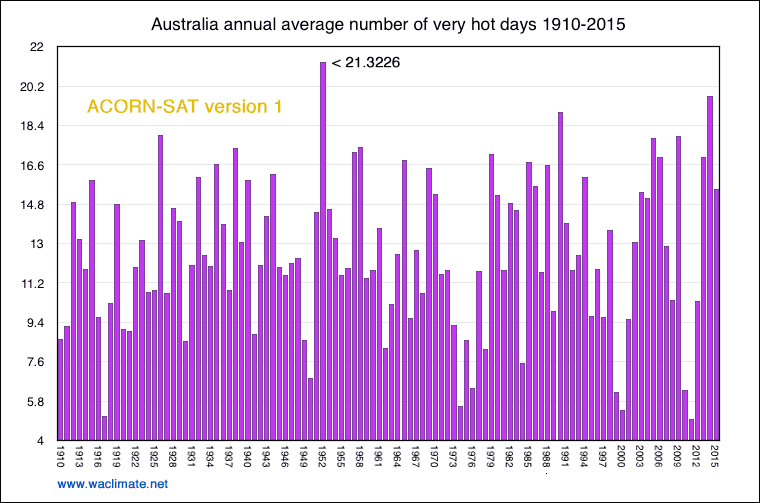History is being wiped out
The Australian Bureau of Meteorology has not only disappeared the Very Hot Days graph but they have wiped out thousands of 40 plus hot days in the years from 1910 – 1963 — years when almost all temperatures in Australia were recorded on Stevenson screens by trained officials under the central management of the Bureau. Volunteer, Chris Gillham, found the data and the changes between ACORN 1 and ACORN 2 and created this transformative graph below.
1952 had more hot days than any year since. Not any more. All those poor sods in 1952 who endured an average twenty one 40-degree-plus days will find now that it wasn’t really that hot. The BoM is like an air conditioner that cools the country 70 years in the past. And it’s only a million dollars a day…
As Craig Kelly MP points out — 2011 had the fewest “very hot days” of the last century, but even the recent data from expert equipment can change eight years later.
Chris Gillham also tested the effect of the latest secret ACORN 2 changes on the “old century” 100F cut off, and found, remarkably that there were more “hotter-than-100” days in the raw data in the first half of last century. All that global warming eh? You’ll be shocked I tell you, shocked, to find that the BOMs latest adjustments change that trend from a fairly stable one to … an increase.
Ponder that with millions more people, concrete and cars in the modern era, it’s the old measurements in good screens in open fields that are being quietly adjusted down, not up, and by secret methods.
If the BOM were a bank adjusting it’s own tax receipts, the Labor Party and Greens would be demanding a Royal Commission.
Check out Chris’s site, a vast amount of data-crunching, all done unpaid. Thank him here!
— Jo
Extreme adjustments distort Australia’s very hot days
Guest post by Chris Gillham who publishes WAClimate
Only a few people know that in early 2019 the Bureau of Meteorology updated its ACORN dataset and increased Australia’s per decade rate of mean temperature warming since 1910 by 23%. The Australian remains the only media that has ever mentioned ACORN 2 or its ramifications. At least 25 million Australians have never heard of ACORN 2 …
Even fewer are aware that ACORN 2 has influenced and distorted the number of days at 40.0C or above, defined by the bureau as “very hot days”, since 1910.

Sweeping changes in record hot days? The Bureau of Meteorology adjusted raw data to make ACORN 1 and has adjusted that further to make ACORN 2!
- At Bourke in NSW from 1910 to 2017 there were 1,909 very hot 40C+ days in RAW (average 41.7C), but in ACORN 1 there were 1,727 very hot 40C+ days (average 42.0C), and in ACORN 2 there were 1,589 very hot 40C+ days (average 41.7C). From RAW to ACORN 2 this is a 16.7% reduction in days.
- At Marble Bar in WA from 1910 to 2017 there were 11,345 very hot 40C+ days in RAW (average 42.4C), but in ACORN 1 there were 10,060 very hot 40C+ days (average 42.5C), and in ACORN 2 there were 9,962 very hot 40C+ days (average 42.4C). From RAW to ACORN 2 this is a 12.2% reduction in days.
- At Alice Springs in the Northern Territory from 1910 to 2017 there were 1,526 very hot 40C+ days in RAW (average 41.1C), but in ACORN 1 there were 1,421 very hot 40C+ days (average 41.1C), and in ACORN 2 there were 1,232 very hot 40C+ days (average 41.1C). From RAW to ACORN 2 this is a 19.3% reduction in days.
- At Boulia in Queensland from 1910 to 2017 there were 4,889 very hot 40C+ days in RAW (average 41.6C), but in ACORN 1 there were 4,236 very hot 40C+ days (average 41.6C), and in ACORN 2 there were 3,500 very hot 40C+ days (average 41.7C). From RAW to ACORN 2 this is a 28.4% reduction in days.
- At Wandering in WA from 1910 to 2017 there were 325 very hot 40C+ days in RAW (average 41.1C), but in ACORN 1 there were 266 very hot 40C+ days (average 41.1C), and in ACORN 2 there were 219 very hot 40C+ days (average 41.2C). From RAW to ACORN 2 this is a 32.6% reduction in days.